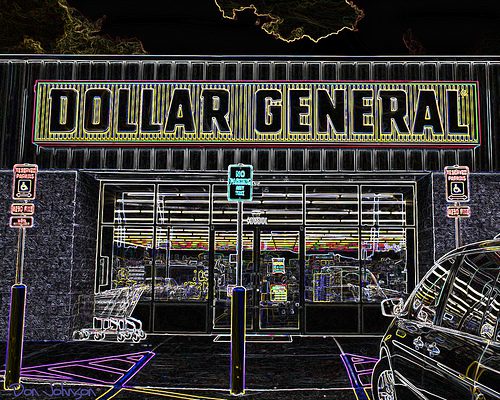When I lived in the big city, there was a Family Dollar among the various retail, cafe, bar and restaurant establishments on the nearby commercial block. In another city I lived in, you could always find a “99 cent” store in the business district. It might have sounded pricey to the generation of the 5 and 10 cent store, but many people today looking for a bargain consider the dollar store as the place to shop. Even if most items actually sell for a little more than a dollar, they cost half what they do at higher-end chain stores, and certainly less than at independently owned shops. At the same time, with all these options and more on the same city block, the dollar store could often blend seamlessly into the commercial landscape.
Now I live in a rural community, and here the dollar store is often one of the few places to shop. Even before the onset of the Great Recession, incomes here were substantially lower than in suburban and urban places, and people always had to look for deals. When the first Wal-Mart in the county opened a couple years ago, it was a huge event. Until that time people had to drive 45 minutes to an hour to shop at all, because there were virtually no stores in the area selling food, clothes, or much else. And what stores did exist often charged too much for essential goods.
The Great Recession has added a new dynamic to the mix. Dollar stores were already a presence in rural communities and towns, but now they are rapidly increasing in numbers. The big dollar chains are ramping up their production as the public seeks to stretch thin paychecks further than ever.
An interesting side benefit of this trend is that these stores are willing to open up in places where the big box stores like Wal-Mart won’t. Dollar stores are typically not so much larger than convenience stores such as 7-Eleven, so they can fit in better in neighborhoods. That’s good news for residents who won’t have to drive 10 miles to buy a quart of milk, or a pad of paper, or diapers.
On the other hand, there is something unnerving about the potential dominance of two or three retail chains in the community. Anyone who has travelled much on the interstate or other major roads is familiar with the numbing sameness of the corporate shopping options in strip malls and big-box centers. But even there at least there are usually some choices.
Or maybe it’s just a matter of making a choice among dollar stores A, B or C.
Photo by Don Johnson 395.

The Dollar Stores Take Their Place on the Block
When I lived in the big city, there was a Family Dollar among the various retail, cafe, bar and restaurant establishments on the nearby commercial block. In another city I […]




The timing of this article is really interesting. I recently moved to a small community in west Texas and noticed how many dollar stores there are in the town. There are at least four dollar stores including, Family Dollar, Dollar General, and 99 Cent stores. I appreciate, like you noted above, that most of the stores are situated into the existing commercial structures and strips. Unlike big box developments, these corporations seem to have little problem adapting their store models to existing structures, which is a great way to re-use space in a community that has an extensive stock of vacant property. Kudos to their flexibility.